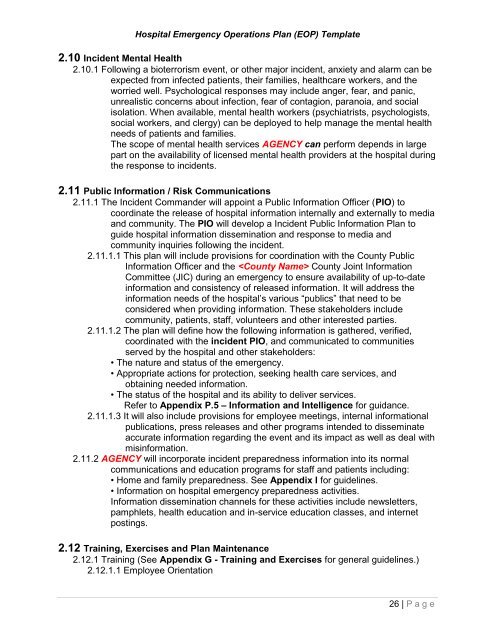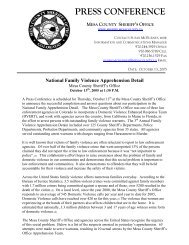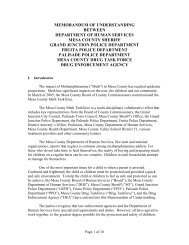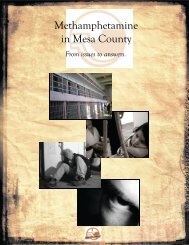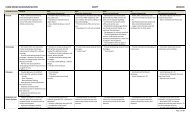Hospital Emergency Operations Plan (EOP) TEMPLATE
Hospital Emergency Operations Plan (EOP) TEMPLATE
Hospital Emergency Operations Plan (EOP) TEMPLATE
Create successful ePaper yourself
Turn your PDF publications into a flip-book with our unique Google optimized e-Paper software.
<strong>Hospital</strong> <strong>Emergency</strong> <strong>Operations</strong> <strong>Plan</strong> (<strong>EOP</strong>) Template<br />
2.10 Incident Mental Health<br />
2.10.1 Following a bioterrorism event, or other major incident, anxiety and alarm can be<br />
expected from infected patients, their families, healthcare workers, and the<br />
worried well. Psychological responses may include anger, fear, and panic,<br />
unrealistic concerns about infection, fear of contagion, paranoia, and social<br />
isolation. When available, mental health workers (psychiatrists, psychologists,<br />
social workers, and clergy) can be deployed to help manage the mental health<br />
needs of patients and families.<br />
The scope of mental health services AGENCY can perform depends in large<br />
part on the availability of licensed mental health providers at the hospital during<br />
the response to incidents.<br />
2.11 Public Information / Risk Communications<br />
2.11.1 The Incident Commander will appoint a Public Information Officer (PIO) to<br />
coordinate the release of hospital information internally and externally to media<br />
and community. The PIO will develop a Incident Public Information <strong>Plan</strong> to<br />
guide hospital information dissemination and response to media and<br />
community inquiries following the incident.<br />
2.11.1.1 This plan will include provisions for coordination with the County Public<br />
Information Officer and the County Joint Information<br />
Committee (JIC) during an emergency to ensure availability of up-to-date<br />
information and consistency of released information. It will address the<br />
information needs of the hospital’s various ―publics‖ that need to be<br />
considered when providing information. These stakeholders include<br />
community, patients, staff, volunteers and other interested parties.<br />
2.11.1.2 The plan will define how the following information is gathered, verified,<br />
coordinated with the incident PIO, and communicated to communities<br />
served by the hospital and other stakeholders:<br />
• The nature and status of the emergency.<br />
• Appropriate actions for protection, seeking health care services, and<br />
obtaining needed information.<br />
• The status of the hospital and its ability to deliver services.<br />
Refer to Appendix P.5 – Information and Intelligence for guidance.<br />
2.11.1.3 It will also include provisions for employee meetings, internal informational<br />
publications, press releases and other programs intended to disseminate<br />
accurate information regarding the event and its impact as well as deal with<br />
misinformation.<br />
2.11.2 AGENCY will incorporate incident preparedness information into its normal<br />
communications and education programs for staff and patients including:<br />
• Home and family preparedness. See Appendix I for guidelines.<br />
• Information on hospital emergency preparedness activities.<br />
Information dissemination channels for these activities include newsletters,<br />
pamphlets, health education and in-service education classes, and internet<br />
postings.<br />
2.12 Training, Exercises and <strong>Plan</strong> Maintenance<br />
2.12.1 Training (See Appendix G - Training and Exercises for general guidelines.)<br />
2.12.1.1 Employee Orientation<br />
26 | P a g e


